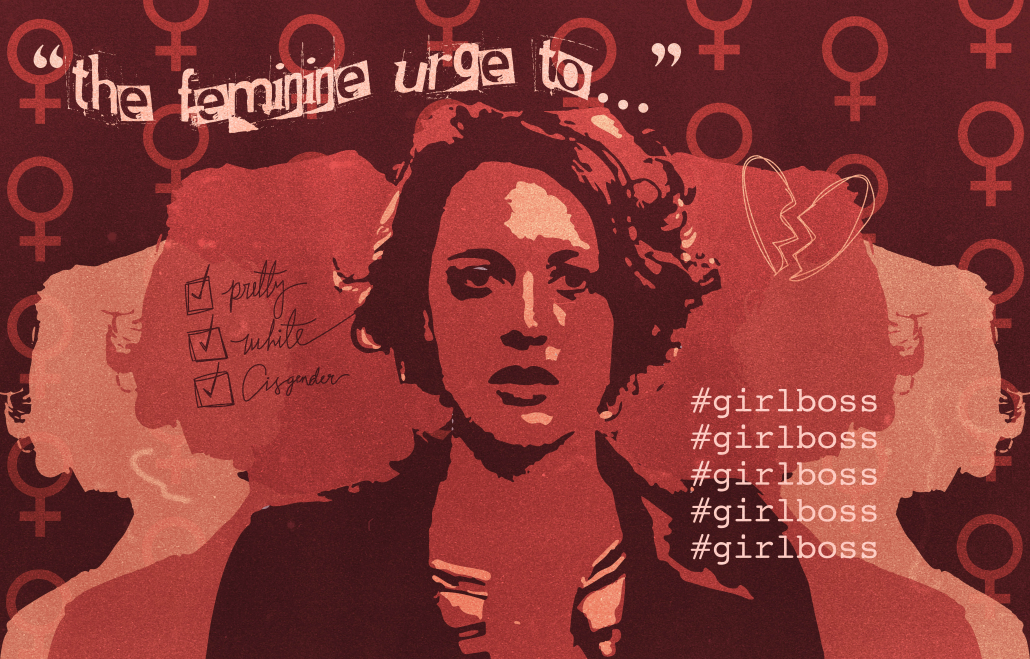Why I won’t be having a ‘Fleabag’ era

Dear diary, I never thought I’d say this, but I am tired of feminism.
Don’t get me wrong, I would still love to off the patriarchy and abolish the systemic inequalities that women face on the daily. But I will burn myself at the stake if I have to hear “Run The World (Girls)” one more time.
The hyper-positivity of mainstream feminism has had people in the streets chanting “Pussy is power!” or emblazoning “#girlboss” on baby pink mugs. But just below the surface — bubbling in a black cauldron, laced with spilled mascara and Lexapro — burgeons a new iteration of feminism that more and more women are beginning to identify with, a growing voice in pop culture: dissociative feminism.
Coined by Emmeline Clein in 2019, dissociative feminism describes a subset of feminism characterized by jadedness and “interiorizing our existential aches and angst, smirking knowingly at them.” Dissociative feminism describes women who, once exuberant soldiers of the gender equality movement, are now exhausted past the point of anger. Feminist author Leslie Jamison identifies the root of dissociative feminism as “aching gone implicit,” reflecting a reaction to the recent plateauing of women’s rights reforms.
In the latter half of the 20th century, women joined the workforce in droves, began to surpass men in earning college degrees and saw the expansion of their reproductive freedoms. However, that progress has since slowed with the stagnation of women’s employment and many women still struggling to break into the many male-dominated fields. Dissociative feminism reflects women’s sense of apathy to the stalling of the gender revolution with the persistence of the wage gap, discrimination in workplaces and, most recently, the vulnerability of reproductive rights.
Continuing an era of gender reform has proved to be awfully difficult and exhausting. We live in increasingly horrifying times when our leaders can’t even band together to stop school shootings, let alone achieve equality. In the race toward gender equality, the finish line seems like a mirage, taunting us with the fantasy of something we’ll never reach. To be a dissociated feminist is to have a seat in the sand and make a sarcastic remark about having to trek through the desert in the first place.
On the individual level, what makes dissociative feminism so alluring is the dissociative aspect of it, which compels women to step outside of their pain to comment on it — to be indifferent about or even relish in it. In the 2019 series “Fleabag,” the titular protagonist constantly leaves her body in the middle of scenes to cheekily comment on her disastrous life as it is happening. Fleabag’s stark awareness and detachment from her actions and their consequences reflect the core of dissociative feminism, albeit, in a more extreme manner.
Dissociative feminism resonates with many women because it describes women’s exhaustion at the stagnant gender revolution and the catharsis of feminine misery. But there is dangerous potential for the fatalistic aspects of the movement to stall the larger fight for equality.
The way dissociative feminism is portrayed in shows and books may seem relatable to many women, but it really isn’t. As writer from “Another Gaze” Rebecca Liu describes, the archetypical dissociative feminist is “pretty, white, cisgender, and tortured enough to be interesting but not enough to be repulsive. Often described as relatable, she is, in actuality, not.” Self-destruction, jadedness and a nicotine addiction are easily romanticized when portrayed in a white, conventionally attractive, upper-middle class woman. To become disillusioned with mainstream feminism is a luxury those who have no other choice aren’t afforded.
Intersectional feminist writer Ione Gamble wrote, “dissociative feminism is interesting to talk about and gives people language to understand things maybe. But what would the next step be?” The value of dissociative feminism stops at reflecting women’s disillusionment or escapism, as characters like Fleabag live in relatively consequence-less realities. But what then?
Phoebe Waller-Bridge won’t single-handedly ensure that working class women have enough to feed their families or that Black and Indigenous women and women of color are free of racialized violence. The bleakness and nihilistic tendencies of dissociative feminism push somewhere between “unproductive and genuinely dangerous,” wrote Clein. While internalizing and joking about one’s pain may be a good way to numb it, it does absolutely nothing to fix it. Dissociative feminism is really only feminism in name. As such, we must look elsewhere for the next wave of the gender equality movement.
This in no way means I won’t be rewatching both seasons of “Fleabag,” smiling knowingly every time Fleabag looks toward the camera. Dissociative feminism pinpoints a moment in feminist history when we’re all, yes, still angry about the patriarchy, but also exhausted from fighting it. But that doesn’t mean we should stop. We can all still enjoy a dramatic cry in between advocating for material change and liberating the marginalized of us — just as long as I never hear “Run The World (Girls)” ever again.

